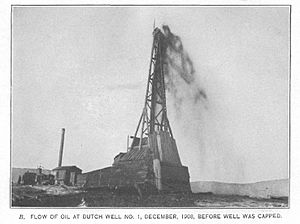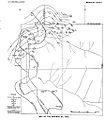Salt Creek Oil Field facts for kids
The Salt Creek Oil Field is a very important place in Natrona County, Wyoming. For a long time, it produced more oil than any other field in the Rocky Mountains region. By 1970, it made about 20% of all the oil in Wyoming.
People knew about natural oil seeps (where oil leaks out of the ground) in this area even before 1880. Later, oil discoveries near Lander led to new claims. In 1889, the first successful oil well was drilled in the Shannon pool. This was done by Philip M. Shannon, who was the president of the Pennsylvania Oil & Gas Company. He even built an oil refinery in Casper in 1895 to process the oil.
In 1906, an Italian geologist named Dr. Porro worked for a Dutch company. He found the spot for the Dutch No. 1 well near a large oil seep. This well was drilled in 1908. It was a "gusher" well, meaning oil shot out with great force. It found oil after drilling through about 300 meters (1,000 feet) of shale rock.
In 1915, a part of the area called Teapot Dome became Naval Petroleum Reserve Number 3. This meant it was set aside for the Navy's oil needs.
How the Oil Field Formed
The Salt Creek Oil Field sits on a special underground rock structure called an anticline. Think of an anticline like a giant upside-down bowl or arch shape in the rock layers. This arch formed a long time ago, during the Late Cretaceous or Early Tertiary times.
This anticline has two main "domes" or high points. The "Salt Creek Dome" is in the north, and the famous "Teapot Dome" is in the south. The oil is found in special underground traps within rock layers. These layers include the Lakota, Sundance, and Tensleep formations. There are also two Frontier formations, which are like ancient offshore sandbars. All these oil-rich layers are mixed with marine shales. The second Frontier formation also extends into the Teapot Dome area. These Frontier layers are found between the Mowry Shale and Niobrara Formation.
Getting More Oil Out
To get even more oil from the Salt Creek field, a method called Enhanced Oil Recovery (EOR) is used. One way they do this is by injecting CO2 (carbon dioxide) into the ground. This helps push more oil out of the rocks.
The CO2 used for this process comes from a natural gas facility. This facility is located in the nearby LaBarge field.
In 2016, some CO2 leaked from an old, unused well in the field. This caused a local school to close temporarily as a safety measure.





